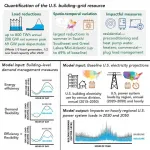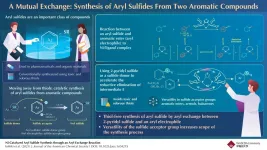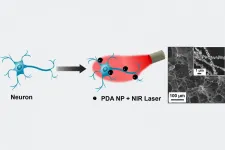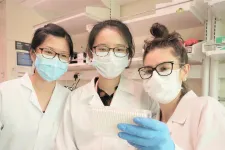(Press-News.org) Since buildings consume 75% of electricity in the U.S., they offer great potential for saving energy and reducing the demands on our rapidly changing electric grid. But how much, where, and through which strategies could better management of building energy use actually impact the electricity system?
A comprehensive new study led by researchers from the Department of Energy's Lawrence Berkeley National Laboratory (Berkeley Lab) answers these questions, quantifying what can be done to make buildings more energy efficient and flexible in granular detail by both time (including time of day and year) and space (looking at regions across the U.S.). The research team, which also included scientists from the National Renewable Energy Laboratory (NREL), found that maximizing the deployment of building demand management technologies could avoid the need for up to one-third of coal- or gas-fired power generation and would mean that at least half of all such power plants that are expected to be brought online between now and 2050 would not need to be built.
Their findings were published recently in the journal Joule.
"A key reason why we don't hear more about the role of our buildings as a significant resource for the clean energy transition is because it's been challenging to quantify that resource at a large scale - and without hard numbers at scale, it's hard for policy makers or grid operators to plan around it," said Berkeley Lab researcher Jared Langevin, lead author of the study. "Our overarching belief here was that producing these kinds of estimates that make the role of these demand-side building technologies more concrete will help ensure that we do more to encourage the deployment of those technologies alongside the deployment of renewable generation and batteries."
"We're excited to collaborate with Berkeley Lab on these research findings, which emphasize the impact of our nation's buildings to achieve a decarbonized energy system," said Achilles Karagiozis, director of NREL's Building Technologies and Science Center.
The so-called demand-side of electricity is electricity that is used in homes and workplaces, such as for air-conditioning, water heating, and powering lights and appliances. The researchers approached this electricity use from buildings as a grid resource; by increasing the efficiency and flexibility of buildings' electricity use, such as by operating higher-performing equipment and shifting the time when its usage takes place, they found this resource to be substantial, avoiding up to 742 terawatt-hours (TWh) of annual electricity use and 181 gigawatts (GW) of daily net peak load in 2030, rising to 800 TWh and 208 GW by 2050. (Total U.S. electricity consumption in 2020 was about 3,800 TWh.)
The researchers found that the most impactful measures for residential buildings were preconditioning (where homes are precooled so as to reduce air conditioning usage at peak times) and using heat pump water heaters; for commercial buildings, plug load management, where software is used to manage the electricity use of computers and other electronic devices in a building, was most impactful.
"Our initial estimates suggest tens of billions of dollars in annual cost savings potential for grid operators - not to mention the potential energy cost savings for families and businesses," said Karagiozis. "Buildings are also a significant source of flexibility for grid operators, primarily in dialing down electricity demand during times when it would normally be at its peak, such as during really hot summer days when most air conditioners are running."
By reducing this peak demand, Langevin said utilities may have lower need for battery technologies as they deploy more renewable energy. "Indeed, the flexible resource we found is comparable to higher-end projections of battery deployment needs under higher renewable energy deployment," he said.
The regions where buildings proved to offer the largest grid resource were in Texas and the Southeast of the U.S., as well as the Great Lakes and Mid-Atlantic regions. "These are areas with high population, strong space conditioning needs, and lots of electric equipment already installed," Langevin said. "This information at the regional scale is really important for developing tangible policies for realizing the resource that we're reporting."
Strategies for capturing the potential building-grid resource that the study identifies are already under development. Recently, for example, DOE released a National Roadmap for Grid-Interactive Efficient Buildings (https://gebroadmap.lbl.gov/), which draws from the study's outcomes and provides concrete recommendations for how to triple the efficiency and flexibility of the buildings sector by 2030.
"Continued efforts along these lines will be critical for establishing a key role for the buildings sector in the future evolution of the U.S. electricity system," said Langevin. "Our findings are encouraging, but now we need to find ways of quickly putting this resource into practice."
INFORMATION:
The study was supported by the Building Technologies Office under DOE's Office of Energy Efficiency and Renewable Energy.
Founded in 1931 on the belief that the biggest scientific challenges are best addressed by teams, Lawrence Berkeley National Laboratory and its scientists have been recognized with 14 Nobel Prizes. Today, Berkeley Lab researchers develop sustainable energy and environmental solutions, create useful new materials, advance the frontiers of computing, and probe the mysteries of life, matter, and the universe. Scientists from around the world rely on the Lab's facilities for their own discovery science. Berkeley Lab is a multiprogram national laboratory, managed by the University of California for the U.S. Department of Energy's Office of Science.
DOE's Office of Science is the single largest supporter of basic research in the physical sciences in the United States, and is working to address some of the most pressing challenges of our time. For more information, please visit energy.gov/science.
Aryl sulfide, an aromatic compound in which sulfur is attached to an aryl (a functional group derived from an aromatic ring), is found in biologically active materials effective against asthma, Alzheimer's disease, and cancer. As a result, chemists have shown a lot of interest in synthesizing aryl sulfides. Traditionally, carbon-sulfur (C-S) bond formation reactions between thiols and aryl electrophiles catalyzed by transition metals have been employed for aryl sulfide synthesis because of their high reliability. However, thiols have an unpleasant smell and are toxic. Could there be a way to synthesize aryl sulfides that avoids the ...
A new study of almost 12,000 Australians has found one-third of the adult population has experienced pure cybercrime during their lifetime, with 14% reporting this disruption to network systems in the past 12 months.
With all forms of cybercrime already costing trillions every year globally, experts from the Australian Institute of Criminology (AIC) and Flinders University say the crimes involved substantial levels of personal victimisation including direct losses as well as the high cost of preventing future attacks.
A pre-COVID-19 snapshot of the cost of 'pure cybercrime' in 2019 has found an approximate ...
Nanomaterials have been used in a variety of emerging applications, such as in targeted pharmaceuticals or to bolster other materials and products such as sensors and energy harvesting and storage devices. A team in the McKelvey School of Engineering at Washington University in St. Louis is using nanoparticles as heaters to manipulate the electrical activity of neurons in the brain and of cardiomyocytes in the heart.
The findings, published July 3, 2021, in Advanced Materials, have the potential to be translated to other types of excitable cells and serve as a valuable tool in nano-neuroengineering.
Srikanth Singamaneni, a materials scientist, and Barani Raman, a biomedical engineer, and their teams collaborated to develop a noninvasive technology that inhibits the electrical ...
It's hard to save what you can't identify. That's been a problem for the endangered salt marsh harvest mouse, which is found only in the salty, brackish waters of the San Francisco Bay area. The mouse competes for space with about eight million humans, and more than three-quarters of its habitat has been eaten by development and land conversion. That loss is expected to increase amid rising sea levels.
Conserving the population has proven tricky, in part because it looks so much like another mouse in the area--the western harvest mouse--that is abundant throughout western U.S.
But scientists from UC Davis have developed a tool, a "decision ...
Researchers from the Antimicrobial Resistance (AMR) Interdisciplinary Research Group (IRG) at Singapore-MIT Alliance for Research and Technology (SMART), MIT's research enterprise in Singapore, alongside collaborators from Biobot Analytics, Nanyang Technological University (NTU) and Massachusetts Institute of Technology (MIT), have successfully developed an innovative, open-source molecular detection method that is able to detect and quantify the B.1.1.7 (Alpha) variant of SARS-CoV-2. The breakthrough paves the way for rapid, inexpensive surveillance of other SARS-CoV-2 variants in wastewater.
As the world continues to battle and contain COVID-19, the recent identification of SARS-CoV-2 variants with higher transmissibility and increased severity has made the development ...
COLUMBUS, Ohio - The parasites that cause severe malaria are well-known for the sinister ways they infect humans, but new research may lead to drugs that could block one of their most reliable weapons: interference with the immune response.
In the study, scientists defined the atomic-level architecture of the connection between a protein on the surface of a parasite-infected red blood cell when it binds to a receptor on the surface of an immune cell.
When that protein-receptor connection is made under normal circumstances, the infected red blood cell, hijacked by the disease-causing parasite, de-activates the immune cell - meaning the body won't fight the infection. A drug designed to fit into that space could block the interaction, allowing the immune system to get to work clearing ...
LA JOLLA, CA--You can't make a banana split without bananas. And you can't generate stable regulatory T cells without Vitamin C or enzymes called TET proteins, it appears.
Regulatory T cells (Tregs) help control inflammation and autoimmunity in the body. Tregs are so important, in fact, that scientists are working to generate stable induced Tregs (iTregs) in vitro for use as treatments for autoimmune diseases as well as rejection to transplanted organs. Unfortunately, it has proven difficult to find the right molecular ingredients to induce stable iTregs.
Now scientists at La Jolla Institute for Immunology ...
DALLAS, July 21, 2021 -- Babies who were breastfed, even for a few days, had lower blood pressure as toddlers and these differences in blood pressure may translate into improved heart and vascular health as adults, according to new research published today in the Journal of the American Heart Association, an open access journal of the American Heart Association.
Research has found that cardiovascular disease risk factors, including high blood pressure, can start in childhood. Studies have also confirmed breastfeeding is associated with lower cardiovascular disease risk in adulthood. However, the amount and length of time breastfeeding that is needed ...
DALLAS, July 21, 2021 -- People who made even small increases in their daily physical activity levels after receiving an implantable cardioverter defibrillator (ICD) experienced fewer incidences of hospitalization and had a decreased risk of death, according to new research published today in Circulation: Cardiovascular Quality and Outcomes, an American Heart Association journal.
Implantable cardioverter defibrillators, also known as ICDs, are battery-powered devices placed under the skin that can detect abnormal heart rhythms and deliver an electric shock to restore a normal heartbeat. According to American Heart Association's Heart Disease ...
An international collaboration elucidates the mechanisms that facilitate accurate identification of moving images. The findings have been published in Nature Communications
Imagine meeting a friend on the street, and imagine that with every step they take, your visual system has to process their image from scratch in order to recognize them. Now imagine if the same thing were to happen for every object and creature that moves around us. We would live in a constant state of uncertainty and inconsistency. Luckily, that is not the case. Our visual system is able to retain information obtained in motion, thereby presenting us with a more consistent picture of our surroundings. These ...





